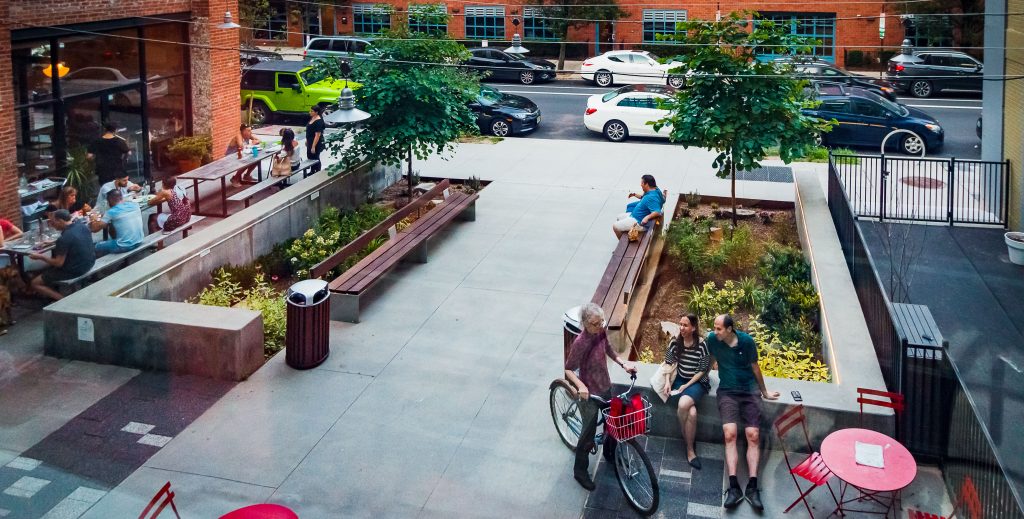By Dave Lustberg, LLA
CEO and Managing Principal, Arterial
February 5, 2020
Vibrant and active public plazas are an important element of successful redevelopment in downtowns and urban areas. Project for Public Spaces states that “(public plazas) are locations where community comes alive, where bonds among neighbors are strengthened and where a sense of belonging is fostered.”
Hoboken’s ‘7th & Jackson Street Resiliency Park’ and Montclair’s ‘Wellmont Arts Plaza’ are two modern examples of public plazas that were designed and constructed with this tenet in mind. While they differ in scale, both spaces were designed and constructed as a public-private partnership between a developer and the city to help foster social interaction, sustainability, and economic vitality.
Read on for the eight key considerations when planning a public plaza.
1. Unique Pedestrian Experience
People derive feelings and opinions about a place based on what they see and experience. Having a positive, well-defined, or unique pedestrian experience in a public space creates a positive feeling that makes them want to return and encourage others to visit. Plazas should be designed to reflect the character, history, and culture of the city, town, or neighborhood within which they are located. Every place is unique — cookie-cutter solutions won’t do the job.
2. Economic Vitality

Rendering of upcoming Wellmont Arts Plaza, Credit: Arterial
Public plazas should be designed to support and enhance the vitality of the adjacent businesses, restaurants, offices, and other uses. When you think of plazas and community growth, you have to consider the revenue the area will bring, either through the arts, markets, or other events.
The more enticing and accommodating a plaza or public place is, the more likely commerce will be successful. Outdoor dining spaces for restaurants, seating that highlights retail spaces, and wayfinding signage are a few of the techniques incorporated into the Wellmont Arts Plaza. At 7th and Jackson where there are adjacent “artist lofts”, a hardscaped plaza was provided that includes lighting, electrical connections and other accommodations for the tenants and others to host outdoor markets.
3. Social Interaction

Space for interaction at the 7th & Jackson Street Resiliency Park, Credit: Arterial
Public plazas bring people together. Redevelopment efforts should be complemented with public spaces that provide a sense of community and togetherness. This also helps bridge any divides between new residents and the existing communities. Community planners agree that there is a lack of social bonds between neighbors, but there is potential to change that. As Medium.com discusses, “Creating an opportunity for people to meet new people in the public space is important because this adds to the sociability of public space.” Whether someone is new to the neighborhood or curious about a new public space, it is vital to consider the social nature of people.
The 7th & Jackson Street Resiliency Park has a variety of uses and flexibility, including a hardscape plaza for events, a large open lawn and a variety of seating. Maximizing the opportunity for social interaction will foster a sense of community.
4. Programming, Activation, and Use

Movies Under the Stars – programming activities at 7th and Jackson Resiliency Park, Credit: City of Hoboken
Designers, planners, and municipal officials often have different approaches to how a plaza should be used. Understanding how a plaza will be activated and programmed is essential. Towns should consider if it will be a place for friends to meet for lunch, for students to learn, for families to attend summer concerts and farmers’ markets – or all of the above! If space exists, it should be used to its full capacity.
Consider the “performance stair” at the Wellmont Arts Plaza that is designed as a staircase for day-to-day use but transforms into a stage for a variety of outdoor events and concerts. The 7th & Jackson Street Resiliency Park offers the opportunity for an abundance of programming including community movie nights, passive recreation and socializing, markets, children’s spaces and quiet areas. In both of these projects, the use of the space was designed with the needs of all stakeholders in mind.
5. Sustainability and Resilience

Use of native plant materials and stormwater storage systems at the 7th & Jackson Resiliency Park, Credit: Arterial
Public plazas offer an excellent opportunity to improve sustainability in downtown while also educating the public about its importance. This has become particularly important with the increase in awareness of global climate change and resilience. Relatively simple interventions like reducing impervious surfaces and introducing green infrastructure — like rain gardens or infiltration planters — helps improve water quality and reduce the strain on the stormwater or combined sewer overflow (CSO) system.
In the summer months, trees and plant material play an important role in providing shade and cooling the ground. As an added benefit year-round, it helps to take rainwater and improve air quality.
The 7th & Jackson Street Resiliency Park is Hoboken’s second post-Sandy resiliency park and will help mitigate any future flooding. It includes a significant reduction in impervious surfaces, the use of native plant materials, and a large underground stormwater storage system. The stormwater system was designed by Langan Engineering and holds approximately 466,000 gallons of water—or about the same amount of water in a 10-year storm.
6. Durable Materials
Think of the romantic Italian piazzas and European streets that would not be the same if not for the hand-laid cobble paving. Rich and durable, these spaces seem to last forever. Juxtapose this against the modern materials commonly found on streets and plazas today such as asphalt, stamped concrete, or faux materials, and we can feel the lacking sense of permanence. We jokingly refer to these as “stage set materials,” because they look good on the day they are installed, but within a few years they begin to lose their luster — a far cry from the Italian Piazza.
The long-term sustainability of a public plaza and how it will fare over time is fundamental. Materials should be selected and constructed to stand for decades or centuries — not just years. High-quality, durable materials ensure the longevity and integrity of the structures. This may cost more upfront – but will reduce the long term maintenance burden placed on the city or town. (And an added benefit is that it keeps materials out of the landfill!). Always consider the long-term costs – not just those upfront.
7. Safety and Access

Safe and equitable spaces for everyone at the 7th and Jackson Resiliency Park, Credit: Arterial
Crime Prevention through Environmental Design (CPTED) principals underscore the importance of planning spaces to minimize the opportunity for negative behavior and maximize the level of safety and feeling of comfort while using the space. Regardless of whether an area is truly unsafe or just feels unsafe, one negative experience can deter a person from returning.
A quick conversation with local police officers and emergency services will help provide insight. Designers and planners should always consider clear sightlines, ample lighting, windows that keep “eyes on the space”, and access into and out of the space. Avoid creating plazas with “backs”, or spaces that are difficult to access and patrol.
Lastly, plazas should be designed with inclusively in mind — considering the needs of all users, including those with disabilities. Referencing The Americans with Disabilities Act is a start, but the more accessible you make a space, the better.
8. Maintenance and Operations
Understanding how a space will be maintained ensures longer-term use. Plazas need to be designed within the means and maintenance capacity of whoever will be responsible for it. For example, a municipality may have limited capacity, while private developers or Business Improvement Districts may not. Establishing these limits help guide the selection of materials, furniture, plants, lighting, and other elements.
Questions to ask while considering maintenance might be:
- How will the plants be watered? Irrigation? Watering Truck? Manually?
- How will the trash be emptied?
- Are there special maintenance vehicles accessing the space?
- Who is responsible for keeping signage up to date?
Whenever possible, engage the community in the maintenance of the plaza. Engaging the community instills a sense of ownership and accountability all while bringing people together.
Renowned urban designer Jan Gehl said it best when he said, “Cultures and climates differ all over the world, but people are the same. They’ll gather in public if you give them a good place to do it.” Developers and municipalities must work together to achieve this “good place” for their community.
Established in 2009, Arterial is a Montclair-based full-service Street Design Studio comprised of landscape architects, planners, and designers passionate about creating great streets and public spaces. The team members at Arterial are casual observers, people watchers, walkers, cyclists and ‘Complete Streets’ advocates. Follow Arterial @ArterialStreets on Twitter, Instagram, Facebook and LinkedIn.


